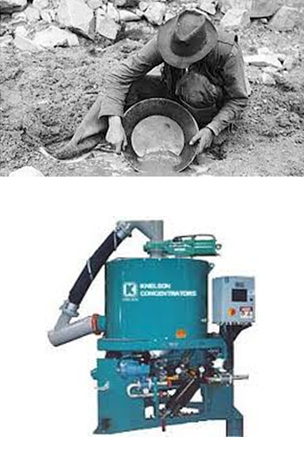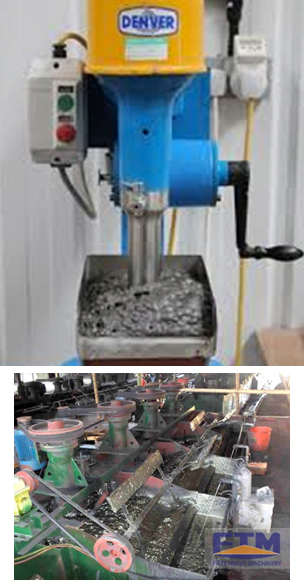Mineral Processing
If the mineralogy of the ore shows that you can separate discrete particles of the mineral you want from the gangue components of the ore, then it is possible to physically concentrate the valuable mineral and reject the rest. The easiest method for achieving this is by gravity separation. This relies on the difference in densities between the ore minerals and the gangue. This method has applications in various stages of a flowsheet; from initial processing to final upgrading. Some of the earliest methods were utilized by the prospectors of the gold rush where they used simple panning techniques to concentrate their ore. Though rudimentary, it is still an applicable process today. The miners of old recovered coarse gold from stream beds but today, mining companies are faced with the problem of lower grades and finer particles.
A Knelson or Falcon concentrator is designed to process fine, free gold that does not require cyanidation for recovery. These use the principle of centrifugal force which aids in the separation process based on the particle density. In the laboratory, these generally are operated as batch processes but can be made to operate continuously.
Our Mineral Processing Services Include:
Gravity Separation
If the mineralogy of the ore shows that you can separate discrete particles of the mineral you want from the gangue components of the ore, then it is possible to physically concentrate the valuable mineral and reject the rest. The easiest method for achieving this is by gravity separation. This relies on the difference in densities between the ore minerals and the gangue. This method has applications in various stages of a flowsheet; from initial processing to final upgrading. Some of the earliest methods were utilized by the prospectors of the gold rush where they used simple panning techiniques to concenrate their ore. Thoughrudimentary, it is still an applicable process today. The miners of old recovered coarse goldfrom stream beds but today, mining companies are faced with the problem of lower grades and finer particles.
A Knelson or Falcon concentrator is designed to process fine, free gold that does not require cyanidation for recovery. These use the principle of centrifugal force which aids in the separation process based on the particle density. In the laboratory, these generally are operated as batch processes but can be made to operate continuously.

Froth Flotation
Froth flotation has been used to separate discrete mineral particles since the early 1900’s. The key to effective separation of the minerals depends on differences in the surface chemistry of the minerals to be separated. The process involves the separation of hydrophobic from hydrophyllic minerals. Flotation has now become the most widely used process for extracting minerals from ores.
Designing flotation schemes in a laboratory allows you to optimize the process. Minerals require coating with a chemical to make their surface hydrophobic. In doing so, the hydrophobic particles adhere to air bubbles that enable them to float. The mineral particles are coated by agitating the ore, water, and suitable reagents. They are then carried to the surface of the pulp, where they enter the froth and are removed from the flotation cell. Unwanted minerals that are naturally hydrophyllic or are treated chemically as such will not float.
This ability to modify the flotation response of minerals has made possible many otherwise difficult separations that are now common practice in modern mills. Flotation is widely used to concentrate copper, lead, zinc, iron and even gold and silver minerals, which commonly accompany one another in their ores. Many complex ores formerly of little value have become major sources of certain metals by means of the flotation process. At McClelland Laboratories, our expertise crosses the breadth of metals and minerals from copper, lead, zinc, gold and silver to chromites, salts, phosphates, tungsten, coal, resins and iron ores. We have studied flotation from feed material, to by-products and even waste streams. Many of these have required the development of specific reagent schemes to optimize the flotation process. In addition, different flotation technologies such as column flotation, flash flotation, and dissolved air flotation have been evaluated. Our test work has been used to develop commercial flotation systems around the world,
Bench scale flotation test programs are designed to evaluate the following parameters:
- Grind size
- Flotation kinetics
- Reagent selection
- Dosage optimization
- Multi-mineral recovery
- pH optimization
- Downstream processing
- Flowsheet design
So whatever type of ore our clients have, we are able to evaluate the metallurgy of processing that ore using leaching, flotation and basic metallurgical procedures like gravity and magnetic separation to optimize the process.




